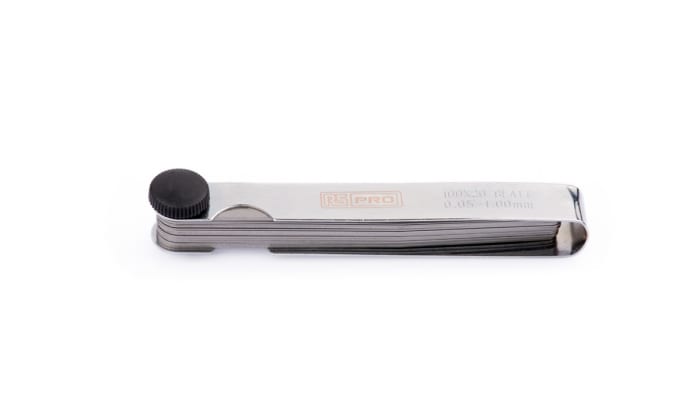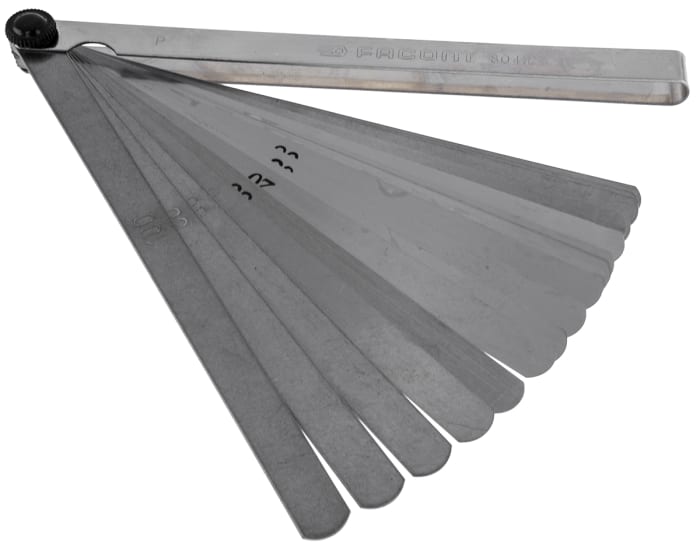Technical Document
Specifications
Product details
Facom Metric Feeler Gauges
These feeler gauges consist of a series of 19 blades secured by a screw to a nickel-plated frame. The size has been etched on the individual blade.
A feeler gauge is a hand-held measuring tool used to measure the size of small gaps between two objects that are in close proximity. The tool has a number of folding metal strips (also known as blades or leaves) which are machined to specified thickness levels. A feeler gauge can be used to gauge a multitude of narrow slots to check that mechanical parts are in safe working order.
Available in 3 versions:
300-6556 - 804.L - extra-long round tip - blade length 150 mm, range 4/100 mm – 25/100 mm, weight 100g
300-6562 – 804.P - standard length pointed tips – blade length 90 mm, range 4/100 mm – 100/100 mm
300-9971 – 804 - standard length round tips – blade length 90 mm, weight 60g, range 4/100 mm – 100/100 mm
Features and Benefits:
Blades are easily removable
The feeler gauges are in metric units
Available in calibrated versions
Typical Applications
Feeler gauges are mostly used in engineering to accurately measure the clearance between two parts to ensure that mechanical parts are in safe working order.
FAQ:
What are feeler gauges used for?
They are used to measure gap widths and to precisely determine the size of the small gap between the two parts.
What to the numbers on a feeler gauge blade?
They can be either imperial units or metric measurements.
Imperial units typically measured in thousandths of an inch and metric in hundredths of a millimetre.
What can feeler gauges measure?
Can be used for checking: tappet clearances, spark plug gaps, distributor points, bearing clearances and piston ring gaps.
EGP 1,330.36
EGP 1,330.36 Each (ex VAT)
1
EGP 1,330.36
EGP 1,330.36 Each (ex VAT)
Stock information temporarily unavailable.
1
Stock information temporarily unavailable.
Technical Document
Specifications
Product details
Facom Metric Feeler Gauges
These feeler gauges consist of a series of 19 blades secured by a screw to a nickel-plated frame. The size has been etched on the individual blade.
A feeler gauge is a hand-held measuring tool used to measure the size of small gaps between two objects that are in close proximity. The tool has a number of folding metal strips (also known as blades or leaves) which are machined to specified thickness levels. A feeler gauge can be used to gauge a multitude of narrow slots to check that mechanical parts are in safe working order.
Available in 3 versions:
300-6556 - 804.L - extra-long round tip - blade length 150 mm, range 4/100 mm – 25/100 mm, weight 100g
300-6562 – 804.P - standard length pointed tips – blade length 90 mm, range 4/100 mm – 100/100 mm
300-9971 – 804 - standard length round tips – blade length 90 mm, weight 60g, range 4/100 mm – 100/100 mm
Features and Benefits:
Blades are easily removable
The feeler gauges are in metric units
Available in calibrated versions
Typical Applications
Feeler gauges are mostly used in engineering to accurately measure the clearance between two parts to ensure that mechanical parts are in safe working order.
FAQ:
What are feeler gauges used for?
They are used to measure gap widths and to precisely determine the size of the small gap between the two parts.
What to the numbers on a feeler gauge blade?
They can be either imperial units or metric measurements.
Imperial units typically measured in thousandths of an inch and metric in hundredths of a millimetre.
What can feeler gauges measure?
Can be used for checking: tappet clearances, spark plug gaps, distributor points, bearing clearances and piston ring gaps.



